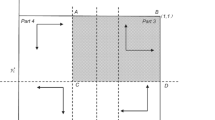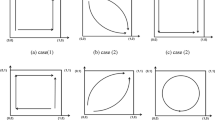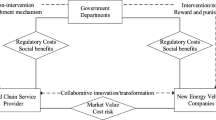Abstract
As a severe challenge to governments, air pollution threatens many lives annually. This paper develops an evolutionary game theory model for supply chains (SCs) to encourage firms to reduce carbon emissions. A government dictates three carbon policies: carbon cap, carbon tax, and cap and trade. We construct six scenarios according to the carbon regulations and SC functions (i.e., centralized versus decentralized ones). First, the profit function of SCs that are the input of the game matrix is formulated, and optimal final prices and quantities of products are obtained. Then, an evolutionary game-theoretic model is formulated to analyze the behavior of populations by obtaining the evolutionary stable strategy under each scenario. In addition, three models of government intervention are presented, considering the cost associated with environmental pollution and government net revenue. Finally, a case study of motorcycle production dissects the results. The findings demonstrate that cap and trade can be introduced as an incentive policy since it encourages SCs to adopt green strategies and improves their profit. A carbon tax policy also succeeds in pressuring SCs to apply green strategies. However, a carbon cap policy fails in forcing SCs to adopt green strategies. Finally, it is concluded that decentralized supply chains (DSCs) handle high tax rates better than centralized supply chains (CSCs).








Similar content being viewed by others
Notes
Read more here: https://bit.ly/3HeIe5V.
Read more here: https://bit.ly/3D40ah8.
Read more here: https://bit.ly/3ooqjkz.
Read more here: https://bit.ly/3CahXSz.
References
Alexander, J. M. (2002). Evolutionary game theory.
An, Y., Zhou, D., Yu, J., Shi, X., & Wang, Q. (2021). Carbon emission reduction characteristics for China’s manufacturing firms: Implications for formulating carbon policies. Journal of Environmental Management, 284, 112055.
Asmus, D., & Griffin, J. (1993). Harnessing the power of your suppliers. The McKinsey Quarterly, 3, 63.
Babu, S., & Mohan, U. (2018). An integrated approach to evaluating sustainability in supply chains using evolutionary game theory. Computers & Operations Research, 89, 269–283.
Barron, E. N. (2013). Game theory: an introduction (Vol. 2). Wiley.
Boronoos, M., Mousazadeh, M., & Torabi, S. A. (2021). A robust mixed flexible-possibilistic programming approach for multi-objective closed-loop green supply chain network design. Environment, Development and Sustainability, 23(3), 3368–3395.
Bravo, J. J., & Vidal, C. J. (2013). Freight transportation function in supply chain optimization models: A critical review of recent trends. Expert Systems with Applications, 40(17), 6742–6757.
Brewer, T. L. (2019). Black carbon emissions and regulatory policies in transportation. Energy Policy, 129, 1047–1055.
Cabinet official, (2020). Available at cabinetoffice.ir/. Accessed Aug 13 2020.
Demiral, M., Akça, E. E., & Tekin, I. (2021). Predictors of global carbon dioxide emissions: Do stringent environmental policies matter? Environment, Development and Sustainability, 23, 1–25. https://doi.org/10.1007/s10668-021-01444-7
Doody, O., & Noonan, M. (2013). Preparing and conducting interviews to collect data. Nurse Researcher, 20(5), 28–32. https://doi.org/10.7748/nr2013.05.20.5.28.e327
Elsner, W., Heinrich, T., & Schwardt, H. (2014). The microeconomics of complex economies: Evolutionary, institutional, neoclassical, and complexity perspectives. Academic Press.
Erdoğan, S., & Miller-Hooks, E. (2012). A green vehicle routing problem. Transportation Research Part E: Logistics and Transportation Review, 48(1), 100–114.
Financialtribune, (2018). Clean air act regulations ready for enactment. Available at financialtribune.com/articles/environment/80061/clean-air-act-regulations-ready-for-enactment. Accessed Aug 13 2020.
Ghorani-Azam, A., Riahi-Zanjani, B., & Balali-Mood, M. (2016). Effects of air pollution on human health and practical measures for prevention in Iran. Journal of Research in Medical Sciences: The Official Journal of Isfahan University of Medical Sciences, 21, 65–72. https://doi.org/10.4103/1735-1995.189646
Gonela, V. (2018). Stochastic optimization of hybrid electricity supply chain considering carbon emission schemes. Sustainable Production and Consumption, 14, 136–151.
Hafezalkotob, A. (2015). Competition of two green and regular supply chains under environmental protection and revenue seeking policies of government. Computers & Industrial Engineering, 82, 103–114.
Hafezalkotob, A. (2017). Competition, cooperation, and coopetition of green supply chains under regulations on energy saving levels. Transportation Research Part E: Logistics and Transportation Review, 97, 228–250.
Hafezalkotob, A. (2018). Direct and indirect intervention schemas of government in the competition between green and non-green supply chains. Journal of Cleaner Production, 170, 753–772.
Halat, K., & Hafezalkotob, A. (2019). Modeling carbon regulation policies in inventory decisions of a multi-stage green supply chain: A game theory approach. Computers & Industrial Engineering, 128, 807–830.
Hassani, A., & Hosseini, V. (2016). An assessment of gasoline motorcycle emissions performance and understanding their contribution to Tehran air pollution. Transportation Research Part D: Transport and Environment, 47, 1–12.
He, X., Prasad, A., Sethi, S. P., & Gutierrez, G. J. (2007). A survey of Stackelberg differential game models in supply and marketing channels. Journal of Systems Science and Systems Engineering, 16(4), 385–413.
Heger, M., & Sarraf, M. (2018). Air pollution in Tehran: health costs, sources, and policies. World Bank.
Iran Asre (2018). A rise of 25% in the price of motorcycles. https://www.asriran.com/002ZJD.
Kim, S. Y., & Shin, H. H. (2015). An analysis of the performance of industry leaders’ suppliers. Asian Review of Financial Research, 28(3), 417–452.
Li, Y., Lim, M. K., Hu, J., & Tseng, M. L. (2019). Investigating the effect of carbon tax and carbon quota policy to achieve low carbon logistics operations. Resources, Conservation and Recycling, 154, 104535.
Liu, M. L., Li, Z. H., Anwar, S., & Zhang, Y. (2021). Supply chain carbon emission reductions and coordination when consumers have a strong preference for low-carbon products. Environmental Science and Pollution Research, 28(16), 19969–19983.
Madani, S. R., & Rasti-Barzoki, M. (2017). Sustainable supply chain management with pricing, greening and governmental tariffs determining strategies: A game-theoretic approach. Computers & Industrial Engineering, 105, 287–298.
Mahmoudi, R., & Rasti-Barzoki, M. (2018). Sustainable supply chains under government intervention with a real-world case study: An evolutionary game theoretic approach. Computers & Industrial Engineering, 116, 130–143.
Matthews, H. S., Hendrickson, C. T., & Weber, C. L. (2008). The importance of carbon footprint estimation boundaries. Environmental Science & Technology, 42(16), 5839–5842.
Moutaoukil, A., Neubert, G., & Derrouiche, R. (2014). A comparison of homogeneous and heterogeneous vehicle fleet size in green vehicle routing problem. In IFIP international conference on advances in production management Systems. Springer, Berlin, pp. 450–457.
Pakseresht, M., Shirazi, B., Mahdavi, I., & Mahdavi-Amiri, N. (2020). Toward sustainable optimization with stackelberg game between green product family and downstream supply chain. Sustainable Production and Consumption, 23, 198–211.
Park*, Y. B. (2005). An integrated approach for production and distribution planning in supply chain management. International Journal of Production Research, 43(6), 1205–1224.
Qu, S., Yang, H., & Ji, Y. (2021). Low-carbon supply chain optimization considering warranty period and carbon emission reduction level under cap-and-trade regulation. Environment, Development and Sustainability, 23(12), 18040–18067.
Rezaei, S., & Maihami, R. (2020). Optimizing the sustainable decisions in a multi-echelon closed-loop supply chain of the manufacturing/remanufacturing products with a competitive environment. Environment, Development and Sustainability, 22(7), 6445–6471.
Rout, C., Paul, A., Kumar, R. S., Chakraborty, D., & Goswami, A. (2021). Integrated optimization of inventory, replenishment and vehicle routing for a sustainable supply chain under carbon emission regulations. Journal of Cleaner Production, 316, 128256.
Sane-Zerang, E., Razmi, J., & Taleizadeh, A. A. (2020). Coordination in a closed-loop supply chain under asymmetric and symmetric information with sales effort-dependent demand. Journal of Business Economics, 90(2), 303–334.
Sathiya, V., Chinnadurai, M., Ramabalan, S., & Appolloni, A. (2021). Mobile robots and evolutionary optimization algorithms for green supply chain management in a used-car resale company. Environment, Development and Sustainability, 23(6), 9110–9138.
Sheu, J. B. (2011). Bargaining framework for competitive green supply chains under governmental financial intervention. Transportation Research Part E: Logistics and Transportation Review, 47(5), 573–592.
Sheu, J. B., & Chen, Y. J. (2012). Impact of government financial intervention on competition among green supply chains. International Journal of Production Economics, 138(1), 201–213.
Sinayi, M., & Rasti-Barzoki, M. (2018). A game theoretic approach for pricing, greening, and social welfare policies in a supply chain with government intervention. Journal of Cleaner Production, 196, 1443–1458.
Sun, H., Wan, Y., Zhang, L., & Zhou, Z. (2019). Evolutionary game of the green investment in a two-echelon supply chain under a government subsidy mechanism. Journal of Cleaner Production, 235, 1315–1326.
Tarigan, A. K. (2019). Expectations, attitudes, and preferences regarding support and purchase of eco-friendly fuel vehicles. Journal of Cleaner Production, 227, 10–19.
Trappey, A. J., Trappey, C., Hsiao, C., Ou, J. J., Li, S., & Chen, K. W. (2012). An evaluation model for low carbon island policy: The case of Taiwan’s green transportation policy. Energy Policy, 45, 510–515.
Waltho, C., Elhedhli, S., & Gzara, F. (2019). Green supply chain network design: A review focused on policy adoption and emission quantification. International Journal of Production Economics, 208, 305–318.
Wang, C., Vaughan, J., Mercer, J., & Zhao, Y. (2011, July). A case-based model facilitating retailing operations going “green”: A proposed research agenda with a consideration of recession. In 2011 IEEE international summer conference of Asia Pacific business innovation and technology management. IEEE, pp. 1–4.
Wang, Z., Wang, Q., Chen, B., & Wang, Y. (2020). Evolutionary game analysis on behavioral strategies of multiple stakeholders in E-waste recycling industry. Resources, Conservation and Recycling, 155, 104618.
Xiao, T., & Yang, D. (2008). Price and service competition of supply chains with risk-averse retailers under demand uncertainty. International Journal of Production Economics, 114(1), 187–200.
Yang, D., & Xiao, T. (2017). Pricing and green level decisions of a green supply chain with governmental interventions under fuzzy uncertainties. Journal of Cleaner Production, 149, 1174–1187.
Yu, P. (2020). Carbon tax/subsidy policy choice and its effects in the presence of interest groups. Energy Policy, 147, 111886.
Zand, F., & Yaghoubi, S. (2022). Effects of a dominant retailer on green supply chain activities with government cooperation. Environment, Development and Sustainability, 24(1), 1313–1334.
Zhang, G., Cheng, P., Sun, H., Shi, Y., Zhang, G., & Kadiane, A. (2021). Carbon reduction decisions under progressive carbon tax regulations: A new dual-channel supply chain network equilibrium model. Sustainable Production and Consumption, 27, 1077–1092.
Zhang, S., Wang, C., & Yu, C. (2019). The evolutionary game analysis and simulation with system dynamics of manufacturer’s emissions abatement behavior under cap-and-trade regulation. Applied Mathematics and Computation, 355, 343–355.
Acknowledgements
This paper has been accomplished on the basis of a MS. dissertation by Lia Nersesian supervised by Prof. Ashkan Hafezalkotob at Department of Industrial Engineering, South Tehran Branch, Islamic Azad University, Tehran, Iran.
Author information
Authors and Affiliations
Corresponding author
Additional information
Publisher's Note
Springer Nature remains neutral with regard to jurisdictional claims in published maps and institutional affiliations.
Appendix
Appendix
Proof of Proposition 1
To obtain the optimal final price, wholesale price, and the quantity of products, the first division of manufacturers' profit function in GSCs and NGSCs must be calculated:
Since \({d}^{2}{\pi }_{{m}_{i}}/d{p}_{i}^{2}<0\) and \({d}^{2}{\pi }_{{m}_{j}}/d{p}_{j}^{2}<0\), \({p}_{i}\) and \({p}_{j}\) can be obtained by solving Eqs. 56 and 57, respectively.
Consequently, \({q}_{i}\) and \({q}_{j}\) are obtained by solving \({q}_{i}={\alpha }_{i}-{p}_{i}+d{p}_{j}\) and \({q}_{j}={\alpha }_{j}-{p}_{j}+d{p}_{i}\), respectively.
Stackelberg follower’s best response is achieved. Therefore, this should be substituted in the supplier profit function to obtain the optimal wholesale price. The first division of the suppliers’ profit function is as follows:
where \(i={g}_{1},{ng}_{1}, j={g}_{2},{ng}_{2}\).
Since \({d}^{2}{\pi }_{{s}_{i}}/d{w}_{i}^{2}<0\) and \({d}^{2}{\pi }_{{s}_{j}}/d{w}_{j}^{2}<0\), \({w}_{i}\) and \({w}_{j}\) can be obtained by solving Eqs. 58 and 59, respectively.
Proof of Proposition 2
To obtain the optimal final price and quantity of products, the first division of GSC and NGSC profit functions must be calculated:
Since \({d}^{2}{\pi }_{i}/d{p}_{i}^{2}<0\) and \({d}^{2}{\pi }_{j}/d{p}_{j}^{2}<0\), \({p}_{i}\) and \({p}_{j}\) can be obtained by solving Eq. (60) and Eq. (61), respectively.
Consequently, \({q}_{i}\) and \({q}_{j}\) are obtained by solving \({q}_{i}={\alpha }_{i}-{p}_{i}+d{p}_{j}\) and \({q}_{j}={\alpha }_{j}-{p}_{j}+d{p}_{i}\), respectively.
Proof of Proposition 3
To obtain the optimal final price, wholesale price, and the quantity of products, the first division of manufacturers' profit functions in GSCs and NGSCs must be calculated:
where \(i = g_{1} ,ng_{1} , j = g_{2} ,ng_{2} .\)
Since \({\mathrm{d}}^{2}{\pi }_{{m}_{i}}/\mathrm{d}{p}_{i}^{2}<0\) as well as \({\mathrm{d}}^{2}{\pi }_{{m}_{j}}/\mathrm{d}{p}_{j}^{2}<0\), \({p}_{i}\) and \({p}_{j}\) can be obtained by solving Eqs. (62) and (63), respectively.
Consequently, \({q}_{i}\) and \({q}_{j}\) are obtained by solving \({q}_{i}={\alpha }_{i}-{p}_{i}+d{p}_{j}\) and \({q}_{j}={\alpha }_{j}-{p}_{j}+d{p}_{i}\), respectively.
Stackelberg follower’s best response is achieved. Therefore, this should be substituted in the suppliers’ profit function to obtain optimal wholesale prices. Since \(\frac{{\mathrm{d}}^{2}{\pi }_{{s}_{i}}}{\mathrm{d}{w}_{i}^{2}}<0\) and \({\mathrm{d}}^{2}{\pi }_{{s}_{j}}/\mathrm{d}{w}_{j}^{2}<0\), \({w}_{i}\) and \({w}_{j}\) can be obtained by solving \(\mathrm{d}{\pi }_{{s}_{i}}/\mathrm{d}{w}_{i}=\) 0 and \(\mathrm{d}{\pi }_{{s}_{j}}/\mathrm{d}{w}_{j}=0\). The optimal wholesale prices are presented below:
Proof of Proposition 4
To obtain the optimal final price and the quantity of products, the first division of GSCs' and NGSCs' profit functions must be calculated:
where \(i={g}_{1},{ng}_{1}\) and \(j={g}_{2},{ng}_{2}\).
Since \({d}^{2}{\pi }_{i}/d{p}_{i}^{2}<0\) and \({d}^{2}{\pi }_{j}/d{p}_{j}^{2}<0\), \({p}_{i}\) and \({p}_{j}\) can be obtained by solving Eqs. (64) and (65), respectively.
Consequently, \({q}_{i}\) and \({q}_{j}\) are obtained by solving \({q}_{i}={\alpha }_{i}-{p}_{i}+d{p}_{j}\) and \({q}_{j}={\alpha }_{j}-{p}_{j}+d{p}_{i}\), respectively.
Proof of Proposition 5
To obtain the optimal final price, wholesale price, and the quantity of products, the first division of manufacturers’ profit functions in GSCs and NGSCs must be calculated:
where \(i={g}_{1},{ng}_{1}\) and \(j={g}_{2},{ng}_{2}\).
Since \({\mathrm{d}}^{2}{\pi }_{{m}_{i}}/\mathrm{d}{p}_{i}^{2}<0\) and \({\mathrm{d}}^{2}{\pi }_{{m}_{j}}/\mathrm{d}{p}_{j}^{2}<0\), \({p}_{i}\) and \({p}_{j}\) can be obtained by solving Eqs. (66) and (67), respectively.
Stackelberg follower’s best response is achieved. Therefore, this should be substituted in the supplier profit function to obtain optimal wholesale prices. Since \({\mathrm{d}}^{2}{\pi }_{{s}_{i}}/\mathrm{d}{w}_{i}^{2}<0\) and \({\mathrm{d}}^{2}{\pi }_{{s}_{j}}/\mathrm{d}{w}_{j}^{2}<0\), \({w}_{i}\) and \({w}_{j}\) can be obtained by solving \(\mathrm{d}{\pi }_{{s}_{i}}/\mathrm{d}{w}_{i}=\) 0 and \(\mathrm{d}{\pi }_{{s}_{j}}/\mathrm{d}{w}_{j}=0\). The optimal wholesale prices are presented below:
Proof of Proposition 6
To obtain the optimal final price and the quantity of products, the first division of GSCs' and NGSCs’ profit functions must be calculated:
where \(i={g}_{1},{ng}_{1}\) and \(j={g}_{2},{ng}_{2}.\)
Since \({\mathrm{d}}^{2}{\pi }_{i}/\mathrm{d}{p}_{i}^{2}<0\) and \({\mathrm{d}}^{2}{\pi }_{j}/\mathrm{d}{p}_{j}^{2}<0\), \({p}_{i}\) and \({p}_{j}\) can be obtained by solving Eqs. (68) and (69), respectively.
Consequently, \({q}_{i}\) and \({q}_{j}\) are obtained by solving \({q}_{i}={\alpha }_{i}-{p}_{i}+d{p}_{j}\) and \({q}_{j}={\alpha }_{j}-{p}_{j}+d{p}_{i}\), respectively.
Rights and permissions
About this article
Cite this article
Nersesian, L., Hafezalkotob, A. & Reza-Gharehbagh, R. Alternative governmental carbon policies on populations of green and non-green supply chains in a competitive market. Environ Dev Sustain 25, 4139–4172 (2023). https://doi.org/10.1007/s10668-022-02237-2
Received:
Accepted:
Published:
Issue Date:
DOI: https://doi.org/10.1007/s10668-022-02237-2




